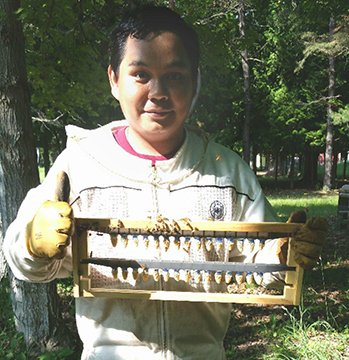
To me beekeeping is more than a job. It is a passion! I am from Tagum City, Davao del Norte, Philippines and I am a Filipino beekeeper, currently working for a commercial operation in Wisconsin. Active on Facebook beekeeping groups, I met and corresponded with the editor of American Bee Journal. She asked me to write about my journey as a beekeeper in the Philippines and in the United States.
I started to delve into the world of beekeeping back in 2014. I was amazed and fascinated by the beautiful and fascinating social life of bees and how they work hard for mother nature. At first, I was terrified of being stung, because I saw how other people reacted to bee venom, swelling up. When I was stung for the first time, I said to myself “This is it!”
And it wasn’t so bad. I have gotten used to bee stings and while they hurt momentarily, I keep working bees. In the Philippines, I was able to witness many different kinds of honey making bees. In my country, we have Apis mellifera (European bees), Trigona/Tetragunula (stingless bees), Apis cerana (eastern honey bee) and Apis breviligula (Giant honey bee of the Philippines). They are all mesmerizing and have different behaviors. I am lucky to come from a country with such bee diversity.
I developed most of my beekeeping management and queen rearing skills working with my brother Peter Paul Rafosala and his wife Claire Jean Rafosala. The two run an apiary named Honey House: Bees & Beeks in our hometown in Tagum City, Philippines. Their apiary focuses on managing A. mellifera and stingless bees. Our region is rich with coconut trees, an excellent and abundant nectar source for honey bees. We have a lot of wild flowers as well. I was trained to love the bees and I put my soul into beekeeping, doing my best to practice excellent hive management. When my brother and his wife moved to Hotsprings, South Dakota to work for a commercial beekeeping company, they left their apiary in my care.
In their absence, I was given a chance to run their apiary on my own, using the techniques they had taught me and their remote guidance. Before they left, they taught me how to graft and showed me how to use the Cloake Board method of queen rearing, which is easy and convenient, though it does require grafting larvae.
In 2016, my brother and his wife returned home to focus on their apiary, and grow it into a sustainable business. We started to conduct seminars and workshops for people interested in beekeeping. Typically, we host a monthly seminar.
Last year, I received a chance to make my own beekeeping journey to the United States. Searching for a beekeeping job online wasn’t easy for me. Many companies denied my application, because they didn’t want to deal with visa requirements. But it was a matter of persistence and perseverance. I kept searching and applying until I found Sweet Mountain Farm, LLC (SMF) on Washington Island, Wisconsin.
Luckily, SMF needed a skilled beekeeper and they considered hiring an H2A worker, which grants a visa for a temporary or seasonal agricultural worker. SMF is a bee farm that breeds pure Russian honey bees. They run a chemical-free apiary and its remote location is an ideal place to maintain pure genetics, because of its isolation. The farm is located approximately 6 miles away from the mainland, and is isolated from the incursion of other genetics.
In the beginning, my life as an assistant beekeeper at SMF was not easy. I had to learn and adapt to their ways of hive management. The move required me to sacrifice some things, so that I could fulfill my plan to be a happy beekeeper in the US. I had to be far from my family and loved ones. The new job required me to be adaptable and accepting of different cultures and beliefs. After the initial culture shock, I have enjoyed my job in the apiary tremendously.
We make detailed hive assessments every 10 days, and I am in the colonies regularly. Raising Russian stock is ideal for northern beekeepers, because the Russian bees are very winter hardy. They also exhibit strong mite resistance and have high levels of hygienic behavior, keeping the colony healthy.
Russian honey bees require very different hive management. I myself had to learn to adapt to their ways, as in the Philippines our European honey bees are a mixed breed. Despite what people think, the Russian bees are no more aggressive. However, they are very prolific in making queen cells during summer and sometimes this continues into the fall. So you have to pay close attention to each colony to avoid swarming.
Compared to other races of bees, the Russian lines enter the winter with smaller clusters. It’s not uncommon for the winter cluster to be only….


